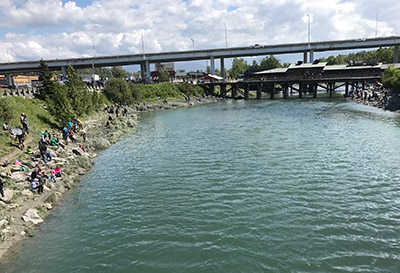
It is late June in Alaska’s largest city. Summer solstice, the longest day of the year; the date upon which the Northland’s moniker “land of the midnight sun” is most readily apparent. The inevitable and imperceptibly slow slide back towards the darkness of subarctic winter is far from the minds of Anchorage residents today. They, like Alaskans throughout the state, are celebrating the season. Celebrating by hiking and bicycling, camping and boating, picnicking and simply soaking up the sun. And, of course, by fishing.
Ship Creek, weaving its way past the warehouses and railyards of Anchorage’s industrial district, is a hive of activity. Anglers young, old, and from all walks of life gather on the banks and wet their line in hopes of a rendezvous with river royalty. Chinook salmon - “kings” in Alaskan parlance - ply these waters, surging in with the high tides as they begin the transition from the salty sea back to the freshwater of their conception. The whirring of dozens of spinning reels being cast fills the air, punctuated occasionally with cries of “fish on!” as those counted among the lucky begin the process of landing their catch.
Further upstream, keen-eyed observers may spot those salmon that have successfully run the gauntlet and escaped the human predation of the creek’s lower stretches. Here, shaded by the leaves and limbs of cottonwood trees, the fish hold in the deeper pools and eddies, biding their time until the eggs and testes inside their bodies fully develop and their coloration changes from the chrome camouflage of the ocean to the dull brick-red of a sexually mature king salmon.
That any of this is possible is due to the hard work of the Alaska Department of Fish and Game (ADF&G), Division of Sport Fish staff at the William Jack Hernandez Sport Fish Hatchery. Nestled along the north bank of Ship Creek just downstream from the old Elmendorf Power Plant dam, it is at this hatchery that these salmon began their lives. Part of a long-established, region-wide program designed to preserve and enhance angling opportunity through the establishment of reliable and accessible fisheries (thus alleviating pressures placed on wild stocks), these fish were raised under human care until their size and age dictated a readiness to make their own way in the world. Eager for the taste of saltwater, they were released into Ship Creek, drifting with the current to its mouth and the briny vastness beyond. Now, they have returned after spending one to six years at sea, evading commercial gillnets, anglers’ hooks, and a thousand manifestations of toothed death. The impetus for their return is a calling as old as the species itself: they have come home to begin the next generation.
No comments:
Post a Comment